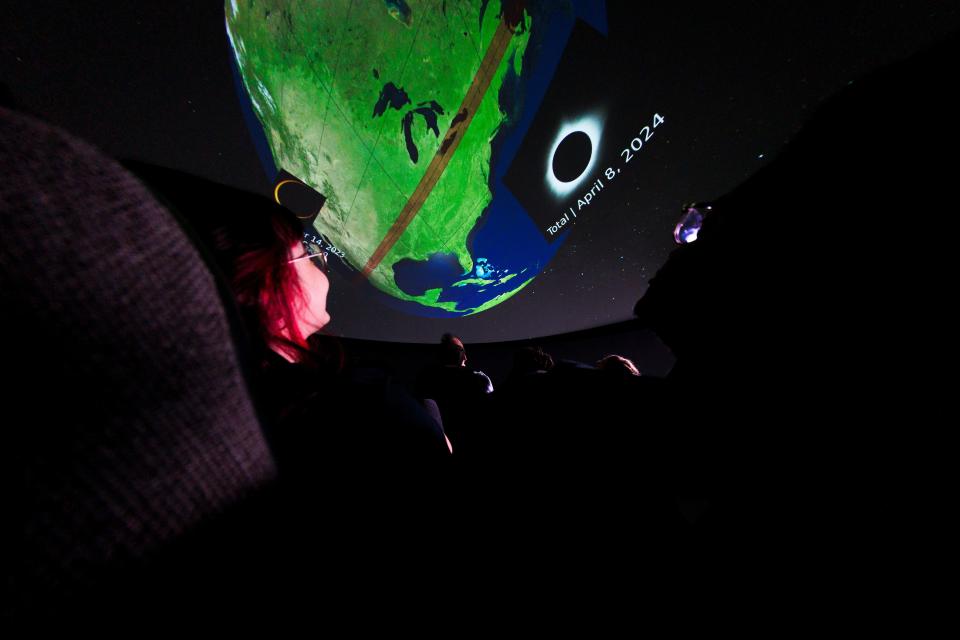Muncie's first total solar eclipse in 1,067 years brings excitement, caution
MUNCIE, Ind. — The first total solar eclipse in the Muncie area in 1,067 years — on the afternoon of Monday, April 8 — has drawn the enthusiastic interest of many East Central Indiana residents, and raised the concerns of a few others.
In the days approaching the eclipse, Ball State University will offer a series of events allowing local residents to learn more about the once-in-a-lifetime event.
On the afternoon of April 8, however — the eclipse will start at 1:52 p.m., and the moon will completely hide the sun from the view of those in the Muncie area, for three minutes and 40 seconds, beginning at 3:07 p.m. — enthusiasts are not encouraged to gather on the Ball State campus.
"The day of (the eclipse) we are suggesting that residents of the city stay at their houses, not drive anywhere, and explore it and experience it in their backyards, to avoid those traffic jams and all of that," said Dayna Thompson, director of Ball State's Charles W. Brown Planetarium.
A local website — https://eclipsemuncie.com/ — features information about local viewing of the eclipse, with links to facilities offering reserved locations, for a price, including Prairie Creek Reservoir and the Academy of Model Aeronautics.
While the path of the total solar eclipse will take in a significant portion of Indiana — from Terre Haute to the southwest to Portland to the northeast, including several Hoosier cities — local officials are hopeful large number of non-local eclipse enthusiasts will center their activities on April 8 in Muncie and Delaware County, utilizing local hotels and restaurants in the process.
It's anticipated the afternoon disappearance of the sun, while brief, might disrupt the schedules of animals — pets, wildlife and livestock.
There is also concern the eclipse could prompt unwise or unsafe behavior among human beings, specifically those operating motor vehicles at the time.
In a news release, Delaware County's Homeland Security and Emergency Management Agency announced preparations were being made "to ensure the safety and well-being of residents and visitors during this extraordinary celestial event."
The county's emergency operations center will be staffed on April 8, "ensuring swift and coordinated responses to any emergent situations."
Volunteers with the Radio Amateur Civil Emergency Service also will be "strategically positioned at key locations throughout the county to monitor and report traffic issues in real time" to the Emergency Operation Center.
There's no documentation, obviously, of how any residents of what would become Delaware County responded the last time the Muncie area experienced a total total solar eclipse — on Wednesday, July 29 in the year 957.
How local residents fare on April 8, however, might be considered the next time the moon briefly blocks Muncie residents' view of the sun — on Wednesday, June 3, 2505.
Protective solar glasses
For the three minutes and 40 seconds that Muncie's view of the sun is completely hidden by the moon, beginning at 3:07:37 p.m. on April 8, the event can safely be viewed without protective eyewear.
During all other stages of the eclipse — which is set to begin that afternoon at 1:52:13 and conclude at 4:24:16 — those gazing at the sun should wear protective solar glasses.
While supplies last, the glasses will be available to the public — with a suggested cash donation of $1 — at Ball State's Charles W. Brown Planetarium, from 11:30 a.m. to 6:30 p.m. on March 14, 21 and 29 and April 4.
The glasses will also be made provided to those attending related shows at the planetarium April 5 to 7.
No glasses will be distributed at the planetarium on the day of the eclipse, according to a BSU release.
According to another release, Makris Vision Group has purchased 60,000 eclipse glasses "for the Delaware County community."
The glasses will be made available to Yorktown residents, and families of students attending Yorktown schools, at Morrow's Meadow from 2 to 6 p.m. on March 13, 15, 18, 20, 22 and 25.
Those glasses will also be available "at most area fire stations," the release said.
Activities at the Charles W. Brown Planetarium
Between April 5 and April 7, events that are free and open to the public that will preview the eclipse are planned at the Charles W. Brown Planetarium on the west end of the Cooper Science Building on the BSU campus.

On Friday, April 5, an "Earth, Moon and Sun" planetarium show is set for 5:30 p.m. A second program, "Eclipse: The Sun Revealed" will begin at 6:30 p.m.
On Saturday, April 6, and Sunday, April 7, hourly programs about the eclipse are planned, from 2:30 to 7 p.m., at the planetarium,.
"Due to construction, select parking and pathway access to the planetarium is blocked off," a Ball State release said. "Plan to arrive early to safely navigate the area and arrive on time for the program."
'A magical night of music' on April 7
On Sunday, April 7, Orchestra Indiana will present "Eclipsed: A Magical Evening of Music," on the east lawn of Minnetrista museum and gardens, 1200 N. Minnetrista Parkway.
According to a release, the concert — featuring "celestial-themed musical selections" — is free and open to the public.
The event will begin at 5 p.m.
Douglas Walker is a news reporter at The Star Press. Contact him at 765-213-5851 or at dwalker@muncie.gannett.com.
This article originally appeared on Muncie Star Press: Locals ready for Muncie's first total solar eclipse since the year 957

